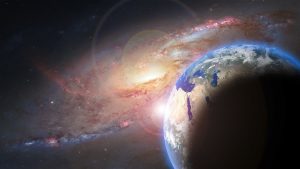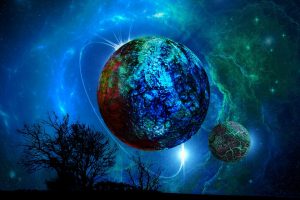Planets Of The Galaxy
Usually when you see a picture of our solar system’s planets, they look something like this:
Now obviously, the relative sizes of the planets are all wrong, and they should be much, much farther apart. And, if you’re using an Apple computer, each planet should be themed with a shiny, candy-like coating. But one other important aspect of the picture is not scientifically accurate. The planets shouldn’t all have the same brightness.

Locations
As you get farther away from the Sun, its light becomes progressively dimmer. I corrected the brightness of the planets in the picture, taking the distance to the Sun into account, and here’s what I got:
Even though Venus is farther away from the Sun than Mercury, it actually appears brighter, because the clouds of its thick atmosphere reflect six times as much light as Mercury’s dark Planet Moon-like surface.
But aside from that, the Sun’s brightness falls off really fast as you move away from it. This is because the intensity of the Sun’s light is proportional to the inverse of the square of its distance. So, if you’re four times farther away from the Zodiac Sign and Sun than Earth is, the Sun will appear sixteen times darker than it would on Earth. Also, the planets are spaced farther and farther apart as you move out in the solar system.

The upshot of all this is, if you were living on a moon of Saturn, you’d have a pretty big heating bill, because that far from the Sun, the temperature would be roughly two hundred degrees below zero in the daytime. Because there are no plants, the atmosphere wouldn’t have any oxygen in it. Plus, the commute would suck and the schools wouldn’t be very good. On the other hand, you wouldn’t have to worry about mowing the lawn, you wouldn’t need sunscreen, and you wouldn’t have to listen to your neighbor’s barking dog all night, because if they let it run around outside, it wouldn’t have anything to breathe as it was freezing to death.
Now, it’s true that if you really were out there orbiting Saturn, you’d still be able to see easily, because your eyes would adjust to the fact that the Sun would only appear one percent as bright as it would near Earth. This is more than enough light to see by. It’d probably be a lot brighter than the light bulbs inside your house at night. But it wouldn’t have quite the same punch as a nice sunny day on Earth.
It’s important to note that your eyes are capable of perceiving a huge range of brightnesses. The full Moon is half a million times dimmer than the Sun, and it still provides just enough illumination to see by if you’re stumbling around in the wilderness at night, being chased by government agents because you’ve just escaped from the secret laboratory where you were grown in a vat. (I am not speaking from personal experience.) So, you wouldn’t have that much trouble getting around near Saturn, even if the sunlight was rather dim.
How is it that NASA’s pictures don’t come out all black? Space probes orbiting the more distant planets simply leave the camera’s shutter open longer to collect more light, brightening up the picture. This is just what a handheld camera does automatically when you use it inside your house.
Explore Planets
Below, on the left, is a picture of the surface of Saturn’s moon Titan, taken by the Huygens probe in 2005. On the right, I’ve corrected the image to account for the intensity of the Sun at that distance, relative to the sunlight on Earth. I’m not kidding here. This is really how much darker it would be. Eventually your eyes would adapt, and you’d see something, but it would be a lot dimmer than Earth during the daytime.
The farther you get from the Sun, the smaller it appears in the sky. The picture on the left, below, is a sunset on Earth, and the picture on the right is a sunset on Mars, taken by the Spirit rover. I’ve scaled the images so that the Sun from Mars is two thirds the size of the Sun from Earth, which is how it really would appear. The sunset on Mars is usually blue because of dust in the atmosphere.
I like looking at the Martian sunset picture and imagining how cold it is there. The fact that the Sun would be a little smaller and dimmer and more blue would make Mars seem extra chilly and desolate and not worth visiting.
We’re pretty lucky that we live on one of the better planets that’s huddling closely around the warmth of our star. Consequently, most of the surface of our planet is often nice and toasty and warm and dry, except of course for the England part of our planet. If you live there, it might seem rather unpleasant, but fortunately, science has demonstrated that it could be much, much worse. You could be living on Titan, freezing in the dark, in a puddle of liquid methane, next to somebody’s dead poodle.

